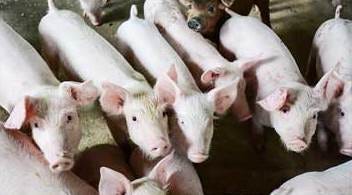Those pesky plasmids have popped up on a pig farm
FDA rules state that ceftiofur can only be used for control and not for prevention which the OSU paper implies was the case not only on this farm, but was "common" practice in the US .

Not to go into too much detail about research by a group of Ohio State University (OSU) investigators that was published Dec 5 in Antimicrobial Agents & Chemotherapy, a journal of the American Society for Microbiology, a peer reviewed journal, but I do need to at least describe the rather scary finding.
In this research, OSU found the carbapenem resistant gene that is carried on a plasmid on a pig farm. Plasmids are scary because they can be transferred from germ to germ, even crossing species lines.

Carbapenem resistant enterobacteriaceae (CRE), which is what they found, are even scarier, so scary some call them “killer germs” because the chance of living if you contract one of these infections is 50-50.
To date, CRE infections in this country have been pretty much limited to health care settings, although some companion animals have been noted to be carriers. Carbapenem can be used by small animal veterinarians to treat Fluffy’s runny nose, but they are banned in animal agriculture.
So how did this bug show up in farrowing barns and a nursery on a large hog confinement facility?
The researchers postulate that it is because Ceftiofur is used routinely in baby pigs at this farm, and Ceftiofur, which is a third generation cephalosporin, is also an antibiotic falling in the beta-lactam class.
Carbapenems are beta-lactams also. Resistance to one beta-lactam can lead to resistance to other beta-lactams.
It is important to note that no CRE was found in the finishing barns, and none was found in the animals themselves.
The messaging of articles and reports regarding this finding in the 48 hours following the release ranged from the sky is falling down to hey, it is just one farm and just one building.
My concern is totally different from what everyone is talking about, and to explain it first I must digress to some FDA activities designed to keep antibiotics working for you and for me.
In 2008 the FDA published a proposed rule that would limit cephalosporin class drugs in animals raised for food, but the push back from the industry must have been huge because the rule was never finalized.
In 2012 the National Antibiotic Resistance Monitoring System (NARMS) showed a rise in third generation cephalosporin resistance in Salmonella from chicken of 18% over 10 years. Resistance rose from 10% in 2002 to 28% in 2012. Cephalosporins are often the drug of choice to treat Salmonellosis in children.
Time for definitive action.
The FDA’s Center for Veterinary Medicine issued an order in 2012 that prohibited the extralabel use of cephalosporin drugs (excluding cephapirin) in pigs and other animals raised for food with a few exceptions.
Specifically the prohibited uses include “using cephalosporin drugs for disease prevention”.
Only two cephalosporins can be used in food-producing animals and they are cephapirin in dairy cattle only and Ceftiofur.
“ Injectable ceftiofur products are approved for the treatment and control of certain diseases, including….”.
The key here is that ceftiofur can only be used for treatment and control, and not for prevention.
These quotes are from the FDA and can be found with more detail at http://www.fda.gov/Animal/VeterinarySafetyHealth/AntimicrobialResistance/ucm421527.htm
Following this order, cephalosporin sales for use in any animals dropped to less than 0.2% of all sales. It sees very limited use and that was designed to reduce or eliminate the development of resistance to beta-lactams and cephalosporin.
By the way, cephalosporin sales in human medicine comprise 15% of all sales so one can understand why this move was so important.
So back to the OSU report and my questions.
In the introduction, the investigators say that “..B-lactams are commonly used in almost all food animal species worldwide including ceftiofur and cefquinome extended-spectrum cephalosporin drugs.”
Cefquinome is not approved for use in food animals in the US.
When I pointed that out to Tom Wittum, one of the authors and researchers, he called it “a passing mention of global use” and doubts that many would come to the conclusion that Cefquinome is used in the U.S.
We are a part of the worldwide effort to raise pigs. Why leave the readers to their own conclusion about its use in our pork industry?
Another quote I find very troublesome is this: “As is common in US swine production, piglets on this farm receive ceftiofur at birth, with males receiving a second dose at castration (=day 6). “
Of course they would not disclose the farm so I could ask about prevention vs. control, but they also would not tell me how many farms they interviewed before they found one using ceftiofur in this fashion, which would appear to me to be to prevent infections which would banned by the FDA.
I checked with Dave Pyburn, Vice President of Science and Technology at the National Pork Board, and he assured me my interpretation of the FDA rules was correct in that ceftiofur can only be used for control and not for prevention which the OSU paper implies was the case not only on this farm, but was “common” practice in the US .
But then he cautioned me that since I did not know anything about the conditions on this farm, they may have had a recent outbreak of some illness I can’t pronounce, much less spell, and that would then bring that use into the control definition and make it legal.
But he seriously questioned the authors’ use of the words “As is common in US swine production…” as he feels it would be rare to use ceftiofur in this fashion for several reasons.
It is illegal
It is very expensive
It goes counter to the oath DVMs take to protect the public’s health
I looked up the latest FDA report on antibiotic sales for use in animals in 2014’ did the math, and found it to be a miniscule 0.2% for cephalosporins. I don’t raise pigs, but it seems to me that if prevention was a common practice, that 0.2% would be a lot higher number in reality.
I hope someone that reads this has the ability, maybe authority, to do some research and find out if this is “common”, or if this is a rare case of misunderstanding the regulations, or if this was indeed using the drug for prevention because of existing conditions not mentioned in the report.
Or worse yet, was this a DVM prescribing the drug with no regards for the CVM’s order in 2012 severely limiting cephalosporin use to protect my Grandkids’ health in the future?
If that is the case, then the long awaited Veterinary Feed Directive due to start January 1 is looking a lot less impressive than most are hoping for.
Maybe Wittum’s last email to me sheds a slightly different light on what OSU may be trying to accomplish through this report.
“…if this had been a finisher barn with a respiratory outbreak instead of piglets in a farrowing barn, we likely would have been reporting in our manuscript that this highly-resistant CRE had been carried by pigs as they entered the food supply.”
Does that mean the ultimate goal is to also eliminate ceftiofur for control as well as for prevention? Hmmm?
About the Author(s)
You May Also Like



